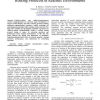Free Online Productivity Tools
i2Speak
i2Symbol
i2OCR
iTex2Img
iWeb2Print
iWeb2Shot
i2Type
iPdf2Split
iPdf2Merge
i2Bopomofo
i2Arabic
i2Style
i2Image
i2PDF
iLatex2Rtf
Sci2ools
VTC
2008
IEEE
2008
IEEE
Operation and Performance of Vehicular Ad-Hoc Routing Protocols in Realistic Environments
—Vehicle-to-vehicle and vehicle-to-infrastructure wireless communications are currently under development to improve traffic efficiency and safety. Routing protocols enabling multi-hop communications represent a major technology for information dissemination within vehicular ad-hoc networks. The high node’s mobility and propagation conditions experienced by vehicle-to-vehicle communications require a careful routing protocol design to ensure its successful operation and performance under realistic environments. To this aim, this paper analyses the impact and importance of adequately considering physical layer effects to correctly quantify a routing protocol’s performance, and understand its networking operation.
Careful Routing Protocol | Communications | Routing Protocol | Vehicle-to-infrastructure Wireless Communications | VTC 2008 |
| Added | 01 Jun 2010 |
| Updated | 01 Jun 2010 |
| Type | Conference |
| Year | 2008 |
| Where | VTC |
| Authors | Ramon Bauza, Javier Gozálvez, Miguel Sepulcre |
Comments (0)

